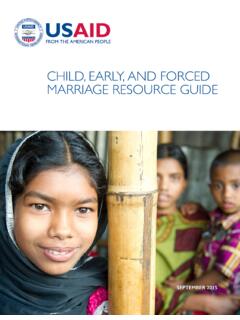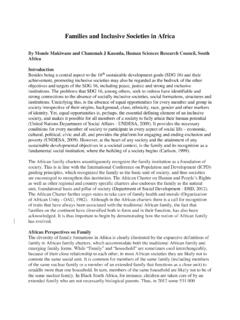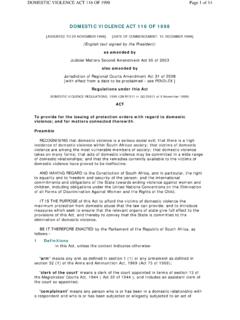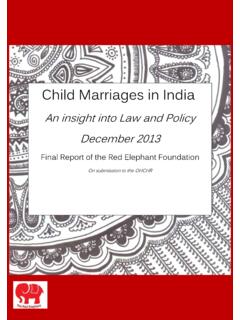Transcription of Child Marriage in Malaysia - UNICEF
1 Child Marriage in Malaysia (Working Paper) Prepared by: Prof Dato Noor Aziah Mohd Awal Mohd Al Adib Samuri Universiti Kebangsaan Malaysia for UNICEF Malaysia 2018 2 Executive Summary I see my friends and next thing you know, they re in Form 5, says a girl who left school in Form 1 to get married, which she now regrets.
2 They re almost out of school. It s a shame I didn t go. The girl, who belongs to the Orang Asli Jah Hut community in Malaysia , is one of 140 boys and girls who were interviewed during the course of this study to gain insight into Child Marriage . There is strong public opposition to the practice in Malaysia , but the data that is needed to provide an accurate and complete assessment of the prevalence of Child Marriage in the country is outdated, unavailable or cannot be made public. Existing evidence, however, indicates that Child Marriage is practised in Muslim, non-Muslim, indigenous and refugee communities in Malaysia .
3 For example, available data shows that there were some 15,000 girls who were married before the age of 15 as of October The researchers also obtained data that showed there were 5,215 cases of married non-Muslim2 female children (16 to 18 years old) from 2005 to October 2015. As for Muslims, the Department of Syariah Judiciary, Malaysia recorded 6,584 cases of Marriage among Muslim children from 2011 to October 2016. According to the 2010 Orang Asli Census, there were 196 married Orang Asli children out of 63,883 married couples in that community in that year.
4 Based on interviews conducted and analysis of Shariah court files, the factors that place children at risk include low household income, which strongly correlates with children dropping out of school. Children who marry tend to have a poor understanding of sexual and reproductive health (SRH) issues, which in turn leads to a higher risk of pregnancy out of wedlock. Parents also lack an effective intervention support system, which leaves many of them believing that Marriage is the best solution when their children become sexually active or become pregnant.
5 Community social norms accept Child Marriage as an option. 1 Malay Mail Online, Child marriages not rare in Malaysia with 15,000 underage brides, activists say 2 Oct 2015, retrieved from: 2 According to the 2010 Population and Housing Census of Malaysia , Bumiputera Malaysians made up per cent of the national population of million, with Chinese Malaysians at per cent, Indian Malaysians at per cent and Others at per cent. Bumiputera consists of Muslim Malays and Orang Asli in Peninsular Malaysia , as well as the indigenous peoples of Sabah and Sarawak.
6 The same census found that Islam was the most widely professed religion and accounted for per cent of the population. Non-Muslim thus included: Buddhism ( per cent); Christianity ( per cent); Hinduism ( per cent); Confucianism, Taoism and tribal/folk/other traditional Chinese religion ( per cent); no religion ( per cent); other religion ( per cent), and unknown ( per cent). See: 3 Several legal and policy bottlenecks hinder efforts to curb Child Marriage in the country. Malaysia s complex legal system which encompasses shariah, civil and customary law makes it difficult to define Child in the context of Child Marriage .
7 For example, civil law stipulates that the legal age of Marriage for non-Muslims is 18 (although females aged 16 to 18 may marry with the consent of their state Chief Minister or Menteri Besar). Muslim law, however, which governs Malaysia s Muslim-majority population, provides that while girls may marry at 16 and boys at 18, the Shariah Court may grant permission to marry below those ages ( below 16 for girls and below 18 for boys). The establishment of a clear minimum age for Marriage at 18 in line with international standards that applies to all existing legal frameworks is therefore a key first step to ending Child Marriage in Malaysia .
8 Although shariah court judges have the authority to grant permission to boys under 18 and girls under 16 to marry, there is no standard operating procedure to guide them through the Child Marriage application process. This leaves judges to their own discretion and their individual understanding of Islamic legal perspectives when assessing each case. This study found that court decisions have usually been made in contravention of the international conventions and laws that Malaysia has ratified, including the Convention on the Rights of the Child (CRC) and Convention on the Elimination of All Forms of Discrimination Against Women (CEDAW).
9 Judges also often rule from the position that Child Marriage is a viable solution to social problems such as pre-marital sexual activity and pregnancy out of wedlock, especially in the case of the latter, as Marriage is perceived to save the baby from illegitimacy. Child Marriage is thus a preferred and acceptable alternative to children being born out of wedlock. According to case files and judges notes made available to researchers, common reasons that shariah court judges gave for approving Child Marriage applications included the children s ability to support a family and manage a household, their memorization of basic Islamic teachings and the availability of family support after Marriage .
10 Reasons judges gave for rejecting Marriage applications included any evidence of coercion, lack of consent from a guardian, a lack of knowledge of basic Islamic teachings, unemployment (for male applicants) and a criminal record. An analysis of case files from the shariah courts of seven states during the period of this study (2012 to 2016) revealed that of 2,143 applications for Child Marriage , only 10 were rejected, emphasizing that Child Marriage is easily accepted within the judicial system. A key policy drawback, meanwhile, is the lack of a clear sex education policy.


















